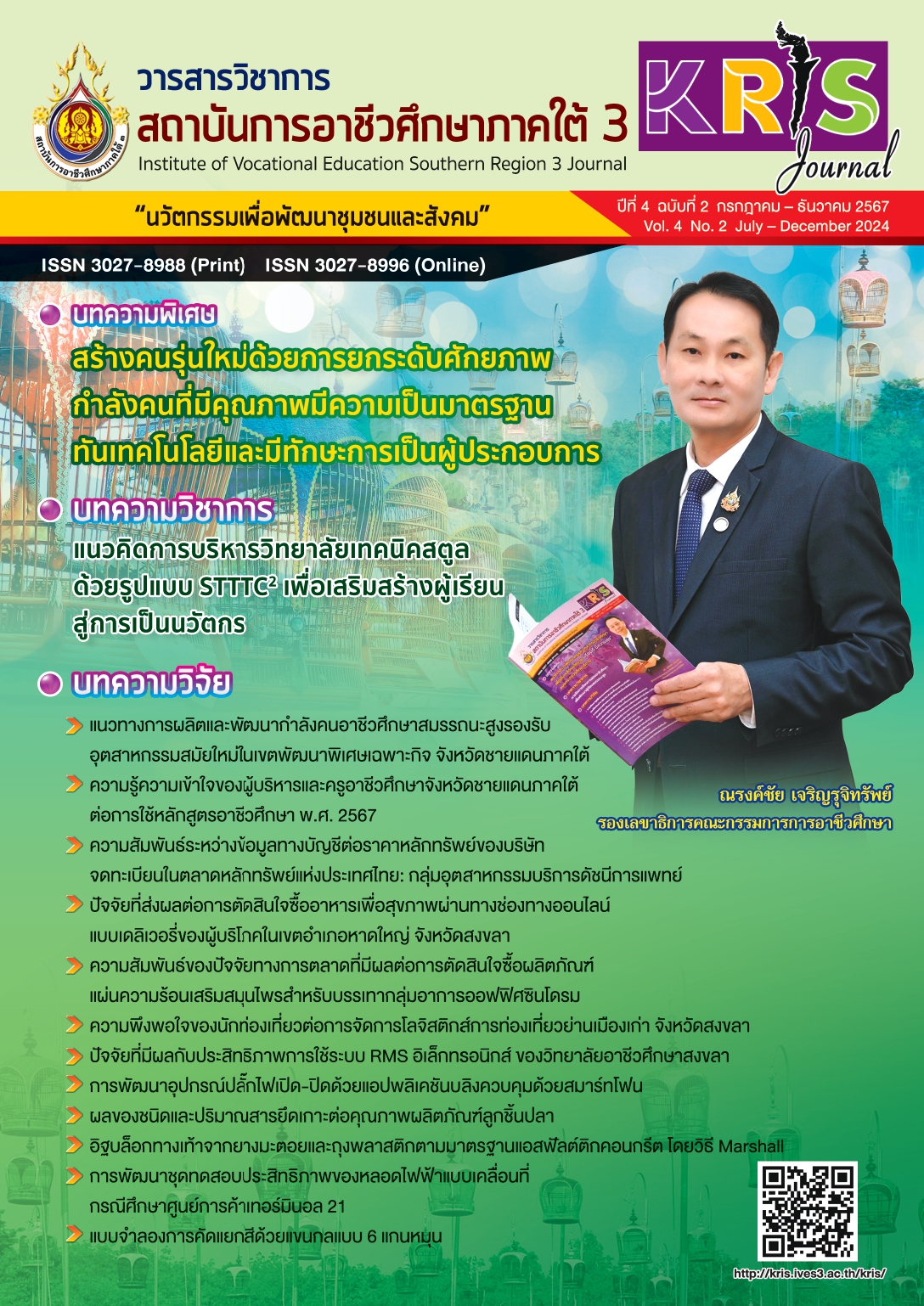Guidelines for Satun Technical College Management Using the STTC2 Model to Develop Students to Become Innovators
Keywords:
the management of Satun, STTC2 model, innovatorsAbstract
This article aims to present a management approach for Satun Technical College using the STTC2 model in order to develop students to become innovators responding the needs of society in the 21st century. The goal is to create a sustainable management framework that aligns with the demands of the digital age and equips students with the necessary skills to become successful innovators. The key elements of the STTC2 management model for Satun Technical College include 5 aspects, i.e., 1) S : Skill Development focusing on developing both professional and life skills, 2) T : Technology Integration incorporating modern technology into the learning process, 3) T : Team Collaboration promoting teamwork through group activities, 4) C : Creativity Enhancement supporting and fostering creativity among students, and 5) C : Community Engagement encouraging participation and collaboration with the community. Through the STTC2 framework, Satun Technical College strives to nurture students who are capable of thinking creatively, applying technology effectively, collaborating efficiently, and engaging with their community. This approach will empower students to become high-quality innovators who will contribute positively to society in the future.
References
United Nations Educational, Scientific and Cultural Organization. (2017). Skills for innovation hubs: Partnering for skills development in technology and innovation. Paris: UNESCO.
OECD. (2019). The future of education and skills: Education 2030. OECD Publishing.
Coley, R. J. (2016). The role of education in the innovation economy. ETS Policy Notes.
Hargreaves, A. (2003). Teaching in the knowledge society: Education in the age of insecurity. Teachers College Press.
Fullan, M. (2001). Leading in a Culture of Change. San Francisco, CA: Jossey-Bass.
Barron, B., & Darling-Hammond, L. (2008). Teaching for Meaningful Learning: A Review of Research on Inquiry-Based and Cooperative Learning. Edutopia.
Robinson, K. (2011). Out of Our Minds: Learning to Be Creative. Oxford, UK: Capstone.
Mishra, P., & Koehler, M. J. (2006). Technological Pedagogical Content Knowledge: A Framework for Teacher Knowledge. Teachers College Record, 108(6), 1017-1054.
Wenger, E. (1998). Communities of Practice: Learning, Meaning, and Identity. Cambridge, UK: Cambridge University Press.
Darling-Hammond, L. (2010). The Flat World and Education: How America's Commitment to Equity Will Determine Our Future. New York, NY: Teachers College Press.
Stiggins, R. J. (2005). Assessment for Learning: Building a Culture of Confident Learners. Phi Delta Kappan, 87(1), 324-328.
Hargreaves, A. (2003). Teaching in the knowledge society: Education in the age of insecurity. Teachers College Press.
Fullan, M. (2001). Leading in a Culture of Change. San Francisco, CA: Jossey-Bass.
Barron, B., & Darling-Hammond, L. (2008). Teaching for Meaningful Learning: A Review of Research on Inquiry-Based and Cooperative Learning. Edutopia.
Robinson, K. (2011). Out of Our Minds: Learning to Be Creative. Oxford, UK: Capstone.
Mishra, P., & Koehler, M. J. (2006). Technological Pedagogical Content Knowledge: A Framework for Teacher Knowledge. Teachers College Record, 108(6), 1017-1054.
Wenger, E. (1998). Communities of Practice: Learning, Meaning, and Identity. Cambridge, UK: Cambridge University Press.
Darling-Hammond, L. (2010). The Flat World and Education: How America's Commitment to Equity Will Determine Our Future. New York, NY: Teachers College Press.
Stiggins, R. J. (2005). Assessment for Learning: Building a Culture of Confident Learners. Phi Delta Kappan, 87(1), 324-328.
Downloads
Published
How to Cite
Issue
Section
License
Copyright (c) 2024 Institute of Vocational Education Southern Region 3 Journal (KRIS Journal)

This work is licensed under a Creative Commons Attribution-NonCommercial-NoDerivatives 4.0 International License.






